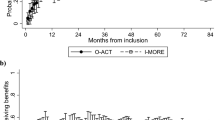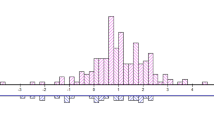Abstract
Objectives To assess changes in participants’ expectations about length of sick leave during Acceptance and Commitment Therapy (ACT)-based occupational rehabilitation, and whether the change in expectations was associated with future work participation. Methods Cohort study with 9 months follow-up including sick listed workers who took part in one of two randomized controlled trials. The change in expectations about length of sick leave were assessed using a test of marginal homogeneity. Furthermore, linear and logistic regression evaluated associations between changes in expectations and sustainable return to work (RTW) and work participation days. Results During rehabilitation, there was a statistically significant improvement in participants’ (n = 168) expectations about length of sick leave. During 9 months follow-up, participants with consistently positive expectations had the highest probability of RTW (0.81, 95% CI 0.67–0.95) and the most work participation days (159, 95% CI 139–180). Participants with improved expectations had higher probability of sustainable RTW (0.68, 95% CI 0.50–0.87) and more work participation days (133, 95% CI 110–156) compared to those with reduced (probability of RTW: 0.50, 95% CI 0.22–0.77; workdays: 116, 95% CI 85–148), or consistently negative expectations (probability of RTW: 0.23, 95% CI 0.15–0.31; workdays: 93, 95% CI 82–103). Conclusions During ACT-based occupational rehabilitation, 33% improved, 48% remained unaltered, and 19% of the participants reduced their expectations about RTW. Expectations about RTW can be useful to evaluate in the clinic, and as an intermediary outcome in clinical trials. The changes were associated with future work outcomes, suggesting that RTW expectations is a strong predictor for RTW.

Similar content being viewed by others
References
OECD. Mental health and work. Paris: Mental Health and Work OECD Publishing; 2013.
Loisel P, Durand MJ, Berthelette D, Vezina N, Baril R, Gagnon D, et al. Disability prevention: new paradigm for the management of occupational back pain. Dis Manage Health Outcomes. 2001;9(7):351–360.
Schultz IZ, Stowell AW, Feuerstein M, Gatchel RJ. Models of return to work for musculoskeletal disorders. J Occup Rehabil. 2007;17(2):327–352. https://doi.org/10.1007/s10926-007-9071-6.
Cornelius LR, van der Klink JJ, Groothoff JW, Brouwer S. Prognostic factors of long term disability due to mental disorders: a systematic review. J Occup Rehabil. 2011;21(2):259–274. https://doi.org/10.1007/s10926-010-9261-5.
Schultz IZ, Crook J, Meloche GR, Berkowitz J, Milner R, Zuberbier OA, et al. Psychosocial factors predictive of occupational low back disability: towards development of a return-to-work model. Pain. 2004;107(1–2):77–85.
Fleten N, Johnsen R, Forde OH. Length of sick leave—Why not ask the sick-listed? Sick-listed individuals predict their length of sick leave more accurately than professionals. BMC Public Health. 2004;4(1):46. https://doi.org/10.1186/1471-2458-4-46.
Carriere JS, Thibault P, Sullivan MJ. The mediating role of recovery expectancies on the relation between depression and return-to-work. J Occup Rehabil. 2015;25(2):348–356. https://doi.org/10.1007/s10926-014-9543-4.
Du Bois M, Donceel P. A screening questionnaire to predict no return to work within 3 months for low back pain claimants. Eur Spine J. 2008;17(3):380–385. https://doi.org/10.1007/s00586-007-0567-8.
Nielsen MB, Madsen IE, Bultmann U, Christensen U, Diderichsen F, Rugulies R. Predictors of return to work in employees sick-listed with mental health problems: findings from a longitudinal study. Eur J Public Health. 2011;21(6):806–811. https://doi.org/10.1093/eurpub/ckq171.
Nieuwenhuijsen K, Verbeek JH, de Boer AG, Blonk RW, van Dijk FJ. Predicting the duration of sickness absence for patients with common mental disorders in occupational health care. Scand J Work Environ Health. 2006;32(1):67–74.
Aasdahl L, Pape K, Jensen C, Vasseljen O, Braathen T, Johnsen R, et al. Associations between the readiness for return to work scale and return to work: a prospective study. J Occup Rehabil. 2018;28(1):97–106. https://doi.org/10.1007/s10926-017-9705-2.
Bandura A. Self-efficacy: toward a unifying theory of behavioral change. Psychol Rev. 1977;84(2):191–215.
Mondloch MV, Cole DC, Frank JW. Does how you do depend on how you think you’ll do? A systematic review of the evidence for a relation between patients’ recovery expectations and health outcomes. CMAJ. 2001;165(2):174–179.
Laisne F, Lecomte C, Corbiere M. Biopsychosocial predictors of prognosis in musculoskeletal disorders: a systematic review of the literature. Disabil Rehabil. 2012;34(5):355–382. https://doi.org/10.3109/09638288.2011.591889.
Iles RA, Davidson M, Taylor NF, O’Halloran P. Systematic review of the ability of recovery expectations to predict outcomes in non-chronic non-specific low back pain. J Occup Rehabil. 2009;19(1):25–40. https://doi.org/10.1007/s10926-008-9161-0.
Costa-Black KM. Core components of return-to-work interventions. In: Loisel P, Anema J, editors. Handbook of work disability. New York: Springer; 2013. pp. 427–440.
Heijbel B, Josephson M, Jensen I, Stark S, Vingard E. Return to work expectation predicts work in chronic musculoskeletal and behavioral health disorders: prospective study with clinical implications. J Occup Rehabil. 2006;16(2):173–184. https://doi.org/10.1007/s10926-006-9016-5.
Brouwers EPM, Terluin B, Tiemens BG, Verhaak PFM. Predicting return to work in employees sick-listed due to minor mental disorders. J Occup Rehabil. 2009;19(4):323–332. https://doi.org/10.1007/s10926-009-9198-8.
Aasdahl L, Pape K, Vasseljen O, Johnsen R, Gismervik S, Halsteinli V, et al. Effect of inpatient multicomponent occupational rehabilitation versus less comprehensive outpatient rehabilitation on sickness absence in persons with musculoskeletal- or mental health disorders: a randomized clinical trial. J Occup Rehabil. 2018;28(1):170–179. https://doi.org/10.1007/s10926-017-9708-z.
Aasdahl L, Pape K, Vasseljen O, Johnsen R, Gismervik S, Jensen C, et al. Effects of inpatient multicomponent occupational rehabilitation versus less comprehensive outpatient rehabilitation on somatic and mental health: secondary outcomes of a randomized clinical trial. J Occup Rehabil. 2017;27(3):456–466. https://doi.org/10.1007/s10926-016-9679-5.
Fimland MS, Vasseljen O, Gismervik S, Rise MB, Halsteinli V, Jacobsen HB, et al. Occupational rehabilitation programs for musculoskeletal pain and common mental health disorders: study protocol of a randomized controlled trial. BMC Public Health. 2014;14(1):368. https://doi.org/10.1186/1471-2458-14-368.
Hayes SC, Strosahl K, Wilson KG. Acceptance and commitment therapy: an experiential approach to behavior change. New York: Guilford Press; 1999.
Hayes SC, Villatte M, Levin M, Hildebrandt M. Open, aware, and active: contextual approaches as an emerging trend in the behavioral and cognitive therapies. Annu Rev Clin Psychol. 2011;7:141–168. https://doi.org/10.1146/annurev-clinpsy-032210-104449.
Reme SE, Tangen T, Moe T, Eriksen HR. Prevalence of psychiatric disorders in sick listed chronic low back pain patients. Eur J Pain. 2011;15(10):1075–1080. https://doi.org/10.1016/j.ejpain.2011.04.012.
Von Korff M, Crane P, Lane M, Miglioretti DL, Simon G, Saunders K, et al. Chronic spinal pain and physical-mental comorbidity in the United States: results from the national comorbidity survey replication. Pain. 2005;113(3):331–339. https://doi.org/10.1016/j.pain.2004.11.010.
Zigmond AS, Snaith RP. The hospital anxiety and depression scale. Acta Psychiatr Scand. 1983;67(6):361–370.
Cleeland CS, Ryan KM. Pain assessment: global use of the Brief Pain Inventory. Ann Acad Med Singapore. 1994;23(2):129–138.
Stuart A. A test for homogeneity of the marginal distributions in a two-way classification. Biometrika. 1955;42(3/4):412–416.
Maxwell AE. Comparing the classification of subjects by two independent judges. Br J Psychiatry. 1970;116(535):651–655.
Skatteboe S, Roe C, Fagerland MW, Granan LP. Expectations of pain and functioning in patients with musculoskeletal disorders: a cross-sectional study. BMC Musculoskelet Disord. 2017;18(1):48. https://doi.org/10.1186/s12891-016-1386-z.
Mancuso CA, Graziano S, Briskie LM, Peterson MG, Pellicci PM, Salvati EA, et al. Randomized trials to modify patients’ preoperative expectations of hip and knee arthroplasties. Clin Orthop Relat Res. 2008;466(2):424–431. https://doi.org/10.1007/s11999-007-0052-z.
Reme SE, Hagen EM, Eriksen HR. Expectations, perceptions, and physiotherapy predict prolonged sick leave in subacute low back pain. BMC Musculoskelet Disord. 2009;10:139. https://doi.org/10.1186/1471-2474-10-139.
Lovvik C, Shaw W, Overland S, Reme SE. Expectations and illness perceptions as predictors of benefit recipiency among workers with common mental disorders: secondary analysis from a randomised controlled trial. BMJ Open. 2014;4(3):e004321. https://doi.org/10.1136/bmjopen-2013-004321.
Laisne F, Lecomte C, Corbiere M. Biopsychosocial determinants of work outcomes of workers with occupational injuries receiving compensation: a prospective study. Work. 2013;44(2):117–132. https://doi.org/10.3233/WOR-2012-1378.
Rise MB, Gismervik SO, Johnsen R, Fimland MS. Sick-listed persons’ experiences with taking part in an in-patient occupational rehabilitation program based on acceptance and commitment therapy: a qualitative focus group interview study. BMC Health Serv Res. 2015;15(1):526. https://doi.org/10.1186/s12913-015-1190-8.
Acknowledgements
The authors thank project coworker Guri Helmersen for valuable assistance, Tryggve Skylstad at the Norwegian Welfare and Labor Service for providing lists of sick-listed individuals and Ola Thune at the Norwegian Welfare and Labor Service for providing sick leave data and insight to the National Social Security System Registry. The authors also thank clinicians and staff at Hysnes Rehabilitation Center and the Department of Physical Medicine and Rehabilitation at St. Olavs Hospital, and the participants who took part in the study.
Author Contributions
LA and MSF conceived the initial idea for this article. All authors contributed to developing the idea. LA and KP performed the analyses. LA wrote the first draft of the article. All authors critically reviewed the manuscript and approved the article.
Funding
The Liaison Committee between the Central Norway Regional Health Authority and the Norwegian University of Science and Technology (Grant No. 46056821); The Research Council of Norway (Grant No. 238015/H20); and allocated government funding through the Central Norway Regional Health Authority.
Author information
Authors and Affiliations
Corresponding author
Ethics declarations
Conflict of interest
Marius Steiro Fimland has been employed at Hysnes Rehabilitation Center, St. Olavs Hospital. Lene Aasdahl and Marius Steiro Fimland have been employed at the Department of Physical Medicine and Rehabilitation, St. Olavs Hospital. The other authors declare that they have no conflict of interest.
Ethical Approval
All procedures performed in studies involving human participants were in accordance with the ethical standards of the institutional and/or national research committee and with the 1964 Helsinki declaration and its later amendments or comparable ethical standards. Informed consent was obtained from all individual participants included in the study.
Rights and permissions
About this article
Cite this article
Aasdahl, L., Pape, K., Vasseljen, O. et al. Improved Expectations About Length of Sick Leave During Occupational Rehabilitation Is Associated with Increased Work Participation. J Occup Rehabil 29, 475–482 (2019). https://doi.org/10.1007/s10926-018-9808-4
Published:
Issue Date:
DOI: https://doi.org/10.1007/s10926-018-9808-4




